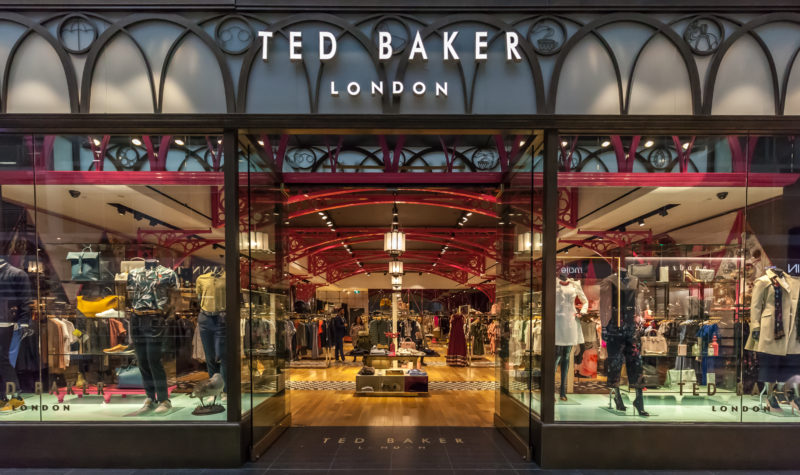Ted Baker is showing good signs of recovery

This iconic fashion brand offers good value as a turnaround play, writes Mark Watson-Mitchell.
Ted Baker is going to make another big loss this year, but only about 40% of that figure was lost last year.
Quite often, bad news has a way of being more than a singular event – and that is just the case with this fashion retail group.
From a ‘cuddling’ boss hitting the headlines to lower profit returns, then falling into massive operating losses, Ted Baker (LON:TED) has been suffering over the last three years or so.
Its shares, which touched £27 each in late 2015, have subsequently collapsed in price, plumbing their depths at 60p in March last year. By last December they were back up to 140p and within five months they had risen another 50% to 212p.
Showing proof that it is correcting itself
At the end of May the group announced that it had managed to secure an extension to its revolving credit facility with its existing lending syndicate.
So, the story the company’s management used to persuade the bankers must have had big elements of merit, certainly enough for them to sign off the agreement.
What is more, I note that in two weeks the group will be holding its AGM and it is looking for shareholders’ permission for it to ‘buy in’ its own shares.
Now that is a mark of confidence, as far as I see it, so perhaps more detail might come out in the AGM trading update.
What does the company do?
Ted Baker is a global lifestyle brand that offers a wide range of collections including Menswear; Womenswear; Accessories; Bedding; Childrenswear; Eyewear; Footwear; Fragrance and Skinwear; Gifting and Stationery; Jewellery; Lingerie and Sleepwear; Men’s Underwear and Loungewear; Luggage; Neckwear; Rugs; Suiting; Technical Accessories; Wallpaper; and Watches.
The group distributes across five continents, it has 521 stores and concessions worldwide, comprising 182 in the UK, 99 in Europe, 136 in North America, 95 in the Middle East, Africa and Asia, and 9 in Australasia.
It operates through its three main distribution channels: retail including eCommerce, (representing some 72.2% of last year’s £352m of sales); wholesale (24.2%); and licensing (12.45%).
On a sales per region basis the UK made up 61.3% of last year’s revenues, the US 29.2%, and the Rest of the World made up 9.5%.
Ted Baker’s purpose is to “live a life less ordinary” while its goal is to be the most engaging lifestyle brand.
What has been going wrong?
In its own words the group describes some of its history to date.
“For more than 30 years Ted Baker has taken everything the world has thrown at it in its stride: the fickleness of changing fashions, the fortunes of boom and recession, the revolving door of bull and bear markets.
“But it is no secret the company got itself into trouble in the last few years. We tackled these issues head on at the end of 2019 and put together a transformation strategy to turn the company around. As we began to put the plan in place, the challenges the company faced were intensified by the onset of the pandemic.”
It goes on to note that,
“Since the end of March last year, it has felt like a ride on a rollercoaster that is still being built, as we hurtle towards the next gravity-defying loop. It has made what would have been a difficult year for Ted Baker far more challenging. Yet we have kept a collective level head and found a way through, ending this terribly challenging year with a grip on the business and a clear transformation strategy in motion.
“And, despite the difficult trading conditions, with much to celebrate and look forward to with a refinanced business, we have an exciting new vision for our product which takes the best of Ted Baker into the future, and an enduring love of the brand by our customers.”
And what is it doing about its situation?
Under the guiding hand of Rachel Osborne, the group’s CEO, the subsequent reorganisation that has taken place inside the group is expected to be the necessary groundwork to enable the progression from the £59.2m underlying pre-tax loss for the year to end-January 2021.
Sector analyst Wayne Brown, at the company’s brokers Liberum Capital, has already pencilled in his estimates for this year and next.
He is looking for sales to increase to £466m (£352m) this year, then on to £553m for the 2023 year.
As far as the recovery process goes, he sees pre-tax losses of £22.9m this year (£59.2m loss) and a bounce back to £28.9m profits next year, worth 12.1p per share in earnings.
A broad equity base
The group has some 185m shares in issue.
Larger shareholders include Toscafund Asset Management (26.1%), Ray Kelvin, founder and former CEO (11.8%), Schroder Investment Management (11.0%), Threadneedle Asset Management (9.70%), KW Investment Management (6.24%), Norges Bank Investment Management (2.90%), River & Mercantile Asset Management (2.09%), Hargreaves Lansdown Stockbrokers (1.98%), Miton Asset Management (1.79%) and Baillie Gifford & Co (1.20%).
My View
I am encouraged by Wayne Brown’s price objective of 225p for the group’s shares, now just 139p.
However, at this early stage in the recovery process, in setting my target price I am cautiously bullish in going for 175p.
Comments (0)